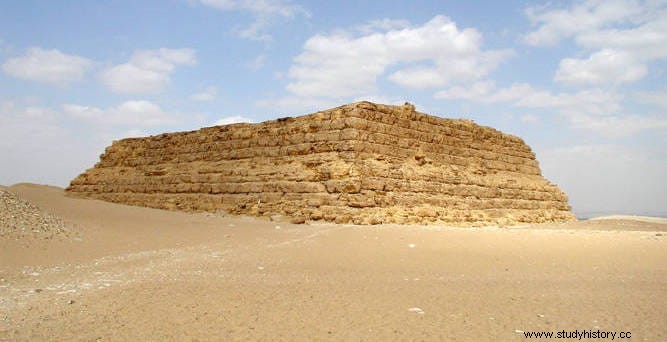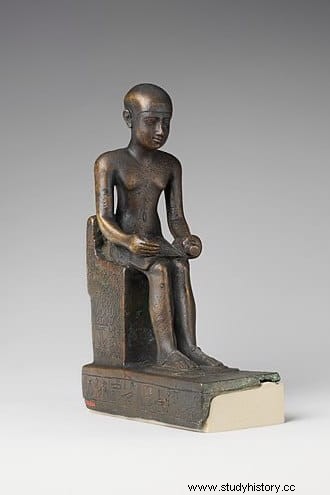In the year 2686 B.C. ascended the throne Necherjet, better known later as Dyeser or Zoser, the second pharaoh of the third dynasty of the Old Kingdom of Egypt. According to Manetho, Djoser ruled for 29 years, although the Turin list says it was only 19. However, the many important construction projects carried out during his reign suggest that Manetho is correct.
The first years of his reign he possibly resided at Abydos in Upper Egypt, where he began the construction of his tomb, as had his predecessors in the First and Second Dynasties.
But when the capital was moved to Memphis, the project remained unfinished. The new tomb would be built in Saqqara, the city's main necropolis on the west bank of the Nile River, some 30 kilometers south of present-day Cairo.

Djoser had for the project Imhotep, the first known architect and engineer in history, his vizier or chati (the highest ranking official, after the pharaoh) and high priest of Heliopolis.
Imhotep, who was also a mathematician, physician, and astronomer, was in charge of planning and supervising all of Djoser's construction projects. So important was Imhotep that his name was even mentioned in the inscriptions on the Pharaoh's statues.

Imhotep conceived for Djoser's tomb a monumental complex with a hitherto unknown structure. He began by building a mastaba, a type of traditional Egyptian tomb with a square or rectangular base with a flat roof and adobe side walls that slope slightly inward. This type of construction was where the pharaohs were usually buried during the Archaic period.
This first mastaba built by Imhotep had an almost square base, about 63 meters on each side and 8 meters high, and was made of stone (for this reason it is considered the first monumental structure in the world made of stone).

But then he had the ingenious idea of building another smaller mastaba on top of this one, and then another, until the structure had six mastabas stacked on top of each other and each one a little smaller than the last. He had created the first pyramid in Egypt.
It is made of solid limestone and has only a narrow corridor that leads to the center of the monument and ends in a crude chamber in which the entrance to the tomb is hidden. When completed and clad in polished white limestone (average 2 meters thick), it stood 62 meters high, by about 121 meters by 109 meters at the base.
During the works, the design was changing and adapting to the needs of the royal family, so the original mastaba was extended to incorporate their tombs.
Under it, a great labyrinth of corridors and chambers almost 6 kilometers long was excavated. Djoser's tomb is right in the middle of this underground complex, 28 meters deep, built of granite and lined with plaster. The entrance was sealed with huge slabs weighing a total of 3.5 tons, placed like pieces of a puzzle.

Some Egyptologists believe that the conception of the pyramidal shape that the initial mastaba became was due to the desire that it be visible from Memphis. Others, on the other hand, believe that the stepped pyramid was always the final form envisioned by Imhotep.
The stepped pyramid of Djoser in Saqqara would be the model that would eventually give rise to the standard pyramidal tomb in the Old Kingdom of Egypt, those of the later IV, V and VI dynasties including the famous pyramids of Giza.

Manetho, writing many centuries later, claims that Imhotep (whom he calls Imuthes) discovered how to build with cut stone in addition to introducing reforms in the writing system and being remembered as a great doctor. Some researchers believe that Imuthes would later be deified by the Greeks under the name of Asclepius (Aesculapius for the Romans).
Since March 2020 you can visit the interior of the first pyramid built in Egypt, after 14 years of restoration work.
